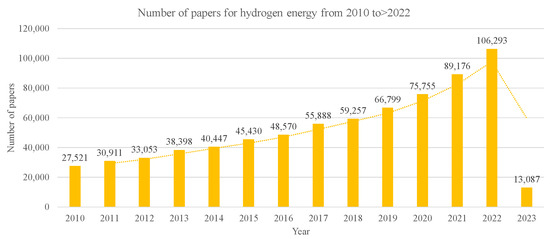The growth of renewable energy actively takes part in decarbonizing the fossil-fuel-based energy system. It reduces carbon emissions, carbon footprint, and greenhouse gas emissions and increases clean energy. The usage of renewable resources reduces and solves several problems, such as increasing temperature, carbon footprint, greenhouse gas emissions, and energy waste. Every sector contributes to increasing the above-mentioned factors in the environment. One of the main reasons for this biodegradation and climate change is energy resources. Using renewable energy instead of fossil fuel can solve the problem. This tpapextr aims to find open research problems about the application of renewable energy and to initiate new innovative ideas regarding renewable energy. A detailed state of the art includes trends for renewable energy resources, their theoretical evolution, and practical implementations. Methodologies used for decision analysis in renewable energy are discussed in detail. The time frame for this analysis of renewable energy is 2010 to >2022. An extensive literature review finds a huge research scope in applying renewable energy in other research, such as logistics, smart production management, and advanced inventory management. Then, major changes in the profit/cost of that system due to renewable energy can be analyzed. This textresearch proposes some innovative new ideas related cost formulas for renewable energy for the corresponding open problems.
- renewable energy
- renewable energy resources
- energy demand
- environmental protection
- supply chain management
1. Introduction
2. Renewable Energy Resources and Their Usage
Many research articles study RE resources, their benefit, methodologies, and applicability. The following renewable energy resources are discussed as- Solar energy
- Wind energy
- Bioenergy
- Hydraulic energy
- Waste to energy and Hydrogen energy
-
Solar energy
-
Wind energy
-
Bioenergy
-
Hydraulic energy
-
Waste to energy and Hydrogen energy
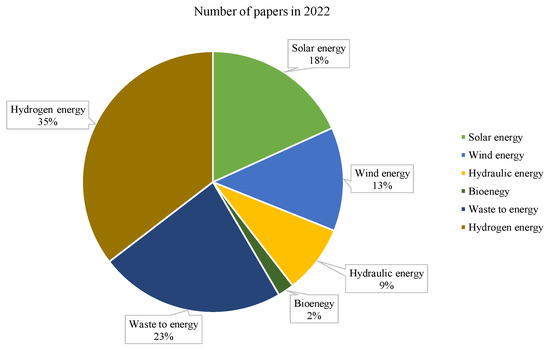
| Articles | Renewable Energy | Contribution | Open Problems | |||||||||
|---|---|---|---|---|---|---|---|---|---|---|---|---|
| Solar | Wind | Bio | Hydraulic | Waste | Hydrogen | Case Study | Review | Model | Management | Methodology | ||
| Köktürk and Tokuç [8][38] | − | Smart grid | − | − | − | − | Turkey | Turkey | − | Yes | − | Yes |
| Watson et al. [9][39] | − | Battery | − | − | − | − | Canada | − | − | − | − | − |
| Ai et al. [10][40] | − | − | − | Storage | − | − | − | Wind turbines | − | Yes | − | Yes |
| Liu et al. [11][41] | − | − | − | Rail vehicles | − | − | − | − | Yes | − | − | − |
| Yu et al. [12][42] | − | − | − | Excavator | − | − | − | − | Yes | Yes | Min-size test | − |
| Yang et al. [13][43] | − | − | − | EHH system | − | − | − | Power system | − | Yes | − | Yes |
| Yang et al. [14][44] | − | − | − | Electric vehicle | − | − | − | − | Yes | Yes | Fuzzy | Yes |
| Wei et al. [15][45] | − | − | − | Wind turbines | − | − | − | − | Yes | − | Simulation | − |
| Abaecherli et al. [16][46] | − | − | − | − | Indust. waste | − | − | − | Mathematical | Yes | MILP | − |
| Zhang et al. [17][47] | − | − | − | − | − | Policy Opt. | China | − | − | Yes | − | − |
| Mohammadi and McGowan [18][48] | − | − | − | − | Brayton cycle | − | − | − | Yes | − | Yes | − |
| Puttachai et al. [19][49] | − | − | − | − | Bi-direc. caus. | − | Germany | − | − | Yes | − | − |
| Lee et al. [20][50] | − | − | − | − | Hybrid system | − | − | Chem. conver. | − | Yes | − | Yes |
| Misganaw and Teffera [21][51] | − | − | − | − | solid | − | Ethiopia | Potential | − | − | − | Yes |
| Apak et al. [22][52] | − | − | − | − | − | Power plant | Yes | Yes | − | Yes | − | Yes |
| Le et al. [23][53] | − | − | − | − | − | Yes | − | − | Yes | − | Yes | − |
| Wei et al. [24][54] | − | − | − | − | − | Yes | − | − | Yes | − | Yes | − |
| Kumar et al. [25][55] | State-of-art | − | − | − | − | − | − | India | − | − | SWOT analysis | Yes |
| Behar et al. [26][56] | Copper mining | − | − | − | − | − | − | Yes | − | − | − | − |
| Xu et al. [27][57] | Solar collector | − | − | − | − | − | − | − | − | − | Simulation | − |
| Lobaccaro et al. [28][58] | Urban planning | − | − | − | − | − | Yes | Yes | − | − | − | Yes |
| Kong et al. [29][59] | − | − | Waste water | − | − | − | − | Recovery | AnMBR | − | − | − |
| Kong et al. [30][60] | − | − | Waste water | − | − | − | − | Recovery | AnMBR | − | − | − |
| Afzal et al. [31][61] | Energy device | − | − | − | − | − | − | Optimization | − | − | Yes | Yes |
| Masera et al. [32][62] | Dairy industry | − | − | − | − | − | Europe | − | − | − | − | − |
| Xiao et al. [33][63] | Food industry | − | − | − | − | − | − | − | Experimental | − | − | − |
| Gao et al. [34][64] | − | Intermittency | − | − | − | − | China | Cost | − | Yes | − | − |
| Bahar et al. [35][65] | − | Analysis | − | − | − | − | − | Tunisia | − | − | − | Yes |
| Govindan [36][66] | − | Barriers | − | − | − | − | − | India | − | − | MCDM | Yes |
| Kong et al. [37][67] | − | − | Waste water | − | − | − | − | Electricity | − | − | − | Yes |
| Jain and Tembhurkar [38][68] | − | − | Fly ash | − | − | − | − | Waste water | − | − | − | Yes |
| Zou et al. [39][69] | − | − | Food waste | − | − | − | − | Enz. pretre. | − | − | − | Yes |
| Li et al. [40][70] | Nanotechnology | − | − | − | − | − | − | Energy storage | − | − | − | Yes |
| Chang et al. [41][71] | − | Anti-icing | − | − | − | − | − | O & M costs | − | − | − | Yes |
2.1. Solar Energy
The use of solar energy is not new in mankind. It starts with a magnifying glass in the 7th century B.C., whereas NASA used the first photovoltaic-based spacecraft in 1964 [42][72]. The development is in the experimental stage anymore; rather, it meets energy demands in daily life. In 2012, solar energy capacity was 100 GW, whereas the growth suppresses 1 TW (1 TW = 1000 GW) in 2022 [43][73]. This growth is almost doubled in the last three years, since 2018, and it is predicted to reach 2.3 TW by 2025 [44][74]. Graph (Figure 26) shows that trends in research on solar energy increase over the year. Until 2020, the moving average curve was flattened and steady. The graph got a hike since 2021 in a different area of application. Abdelrazik et al. [45][75] discussed the potential of adopting solar energy in Africa. They explained that Africa is a great source of photovoltaic power from the sun but faces a lot of challenges for RE due to financial, human, and technological resources. Hao et al. [46][76] analyzed the performance of solar power systems for heating, cooling, and power storage system with a combination of sunbeam splitting. Similarly, a thermochemical reactor used the biomimetic bone porous structure (Shi et al. [47][77]) to improve solar energy conversion. They proved that this method helped to maintain the flow between energy and energy flow within the reactor. That process improved 2.17% solar energy storage efficiency and 8.97% methane conversion.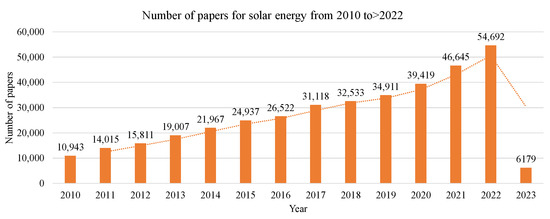
2.2. Wind Energy
The growth of wind energy is gradually increasing every year, and corresponding research articles are growing as well (Figure 37). The history of using wind energy is very old (maybe B.C.), but commercial use started around the 11th century. People began to use windmills for food production in the Middle East. Around the 1800s, Dutch and U.S. people used small wind turbines for farms and cattle ranches [56][86]. Wind power production reached 31,000 MW around the 2000s [57][87]. Two types of wind energy are in progress: one is land-based wind energy, and the other one is offshore wind energy. Land-based wind energy projects are built on land. 99% of wind energy projects are based on private lands [58][88]. In comparison, offshore wind energy projects are built in water (generally seawater). It has fewer conflicts than onshore wind projects due to land issues.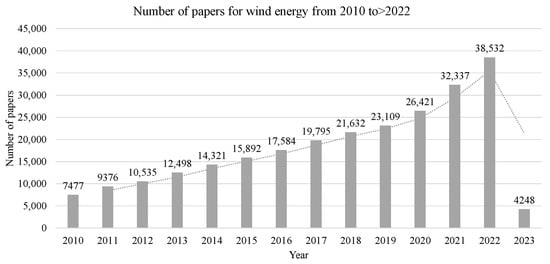
2.3. Bioenergy
Bioenergy is one of the promising renewable energies [67][96], which is produced from biomass (Figure 48). 55% of the total RE comes from bioenergy. Different kinds of bioenergies are biofuel (first, second, third, and fourth generation), biodiesel, and biopower. First-generation biofuel is made from edible biomass. However, it starts to affect the food supply chain worldwide. Then the second-generation biofuel starts to make from nonedible biomass. Still, it affects the wildlife food chain. The third-generation biofuel is made from algae. The third-generation biofuel is more dense, low-cost, and highly energy-efficient. However, it requires a high source of energy to generate lipids. Thus, the fourth-generation biofuel, whose biomass is modified microalgae, comes into the picture. These algae are highly efficient in absorbing CO2CO2 and enhance production fuel [68][97]. Papilo et al. [69][98] gave a review in Indonesia, where palm oil was used for bioenergy. Liu et al. [70][99] discussed a relation between ecological footprint and bioenergy and its effect on the economy. They reviewed the connection using the quantile-on-quantile methodology. Liu et al. [71][6] explained a prediction on the climate change effect on bioenergy, where the biomass was perennial grass. Few studies are found in bioenergy literature, which is used in other sectors as well.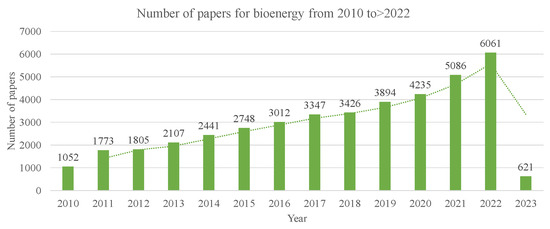
2.4. Hydraulic Energy
Hydraulic energy is a RE where the force of water is used to make the energy. It is mostly used to produce electric energy from the kinetic energy of water. Figure 59 shows the research paper publication for hydraulic energy. The graph is increasing, but it is steady growth. The Spread of RE usage depends on the activity of people as well. Available information about RE in a public forum is important for that. Detailed available information will make society understand the benefit of RE over traditional fuels. This aspect was discussed by Meirinhos et al. [81][109] for the city of Angolan, Central Africa. The city was excessively dependent on oil and caused too much emissions. That study found that hydraulic and biofuel are the two most promising RE. The tidal force is another significant resource of hydraulic energy. Yin et al. [82][110] designed a turbine H∞ that could increase the tidal energy conversion. Their case study analysis using linear matrix inequality (LMI) showed that the energy efficiency of the proposed turbine was up to 40%.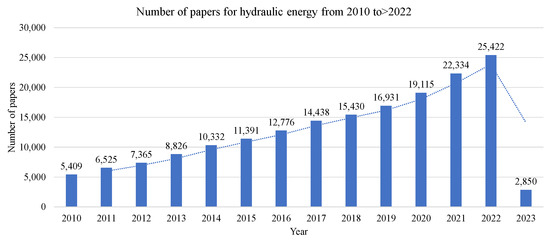
2.5. Waste to Energy and Hydrogen Energy
Waste to energy conversion reduces waste as well as produces energy. Without increasing waste and pollution, waste is used as a promising RE source. There are a lot of different types of waste as food waste, solid waste, municipal waste, and organic waste [88][116]. Conversion equivalency between waste and fossil fuel sources can be represented as: 1 t oil ≃ 4 t wastes and 1 t coal ≃ 2 t wastes [89][117]. Waste to energy conversion has a huge impact on waste management as well as a circular economy. The reason for the impact on circular economy is that the circular economy transfers waste to a new product and waste to energy does the same by converting waste mass balance to energy. Generally, heat or/and electricity are produced from wastes. Figure 610 shows a steady graph for the research in the area of waste to energy.
